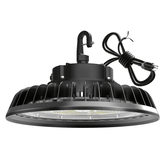Optimal LED light for work environments?
Is optimal lighting important in a work environment?
As we all known, from the workers' perspective, poor lighting at work can lead to eye-strain, fatigue, headaches, stress and accidents. On the other hand, too much light can also cause safety and health problems such as “glare” headaches and stress. Fortunately, GGJIA have a wide range of lights of industrial lighting for choose, such as
- Temporary Work Lights
- Loading Dock Lights
- Tripod Lights
- Construction String Lights
- High Bay UFO Lights
- High Bay Linear Lights

Key Factors to Consider when Choosing LED Lights for Work Environments
Light Quality
- Spectral distribution: If the light emitted by a light source contains the same spectral composition as the light emitted by a blackbody at a certain temperature, it is called a certain K color temperature. GGJIA all series of the lights are 5000k.
- Color temperature (warm vs. cool): Theoretically, blackbody temperature refers to the color of the absolute blackbody after heating from absolute zero (-273 ° C). After the black body is heated, it gradually turns from black to red, yellow, white, and finally emits blue light.
- Color rendering index (CRI): Color Rendering Index (CRI) is a measurement of how natural colors render under an artificial white light source when compared with sunlight. The index is measured from 0-100, with a perfect 100 indicating that colors of objects under the light source appear the same as they would under natural sunlight.
Room Lighting Calculator
Result:
Light Quantity
- Illuminance levels (lux): In lighting terminology, ‘illuminance’ refers to the intensity of light on a surface, measured in lux. An illuminance of over 100 lux means there are more than 100 lumens per square meter on that surface.The appropriate illuminance for a space depends on its intended use. Generally, home illumination levels range from 100 to 500 lux, while offices or shops typically require 300 to 1000 lux.
- Lumen output: Lumens (symbol: lm) measure the total amount of visible light emitted by a lamp or light source that is perceivable to the human eye. The higher the lumen output, the brighter the lamp will appear.
Light Distribution
- Beam angle: With an impressive efficiency of 150 lumens per watt, our 210W commercial LED linear high bay light delivers an outstanding lumen count of 31500. Coupled with a broad 90-degree beam angle and a commendable CRI rating of 80, these indoor linear high bay light fixtures guarantee exceptionally bright 5000K illumination. Illuminate your space with unparalleled brilliance and clarity.
- Diffusion and glare control: G GJIA® Professional Optics 90 Degree PC Reflector with Professional Anti-Glare Diffuser: This specialized reflector efficiently mitigates glare, ensuring that your high bay lights remain bright yet gentle on the eyes, providing a softer and more comfortable illumination.
Energy Efficiency
- Wattage: The watt is a unit of measurement used to calculate electricity and belongs to the International System of Units (yes), it is called watt. One watt is equivalent to one joule per second, which means that a device that consumes one watt of power consumes the equivalent of one joule of energy per second. Continuing with the example of an 100-watt light bulb, if it stays on for one hour, it consumes a total of 360.000 joules of heat.
- Lumens per watt (efficiency): A lumen is a measure of how much visible light is emitted by a source. Lumens per watt (lm/W) refers to the energy efficiency of lighting: how much visible light you get for a given amount of electricity. For example, a High Bay LED UFO Lights 150 watt incandescent bulb in the GGJIA Lights produces 22,500 lumens.
Human-centered design
- Circadian rhythm and blue light considerations: In GGJIA, Our wall pack and shoebox lights have light sensors that automatically turn on at night or in dim situations without human intervention.
- Dimming and tunable features: GGJIA offers 0-10V dimmable LED lights in various models: High Bay UFO, Parking Lot, Canopy, Wall Pack, and Linear High Bay. Not all light fixtures can be dimmed, but GGJIA’s dimmable LED lights can function without a dimmer switch, providing 0-10V adjustable features.
Safety and Compliance
- Certification standards (e.g., UL, CE): When purchasing high bay LED lights, ensure they meet recognized safety and quality standards such as UL, DLC, or CE certifications. These certifications confirm that the lights have been tested for energy efficiency, durability, and safety. Additionally, selecting products with a solid warranty (typically 5 years or more) can protect your investment and provide peace of mind regarding product performance.
- Hazardous material considerations



Ease of Installation and Maintenance
- Mounting options
- Heat dissipation
- Lamp life and warranty: A 400-watt MH lamp can be replaced with a 200-watt GGJIA LED, reducing energy consumption by 50%. Similarly, a 100 watt MH lamp can be replaced with a 50 watt GGJIA led, and the energy consumption is halved. Comparison with other lightweight types: Metal halide (MH) : Life of approximately 25,000 hours. Fluorescent bulbs: 7,000 to 15,000 hours of life, 50 to 100 lumens per watt. Incandescent bulb: life 750 to 2000 hours, 60 lumens per watt.
Finally, GGJIA has more than 17 years of business, in the LED Lights continuous progress, if you have any questions or confusion, please contact our sales team, we will answer you in time.








